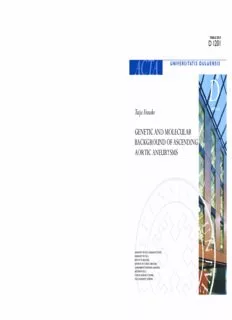
Genetic and molecular background of ascending aortic aneurysms PDF
Preview Genetic and molecular background of ascending aortic aneurysms
D OULU 2013 D 1201 1 2 0 1 UNIVERSITY OF OULU P.O.B. 7500 FI-90014 UNIVERSITY OF OULU FINLAND ACTA A UNIVERSITATIS OULUENSIS A C T A U N I V E R S I T A T I S O U L U E N S I S C T A D S E R I E S E D I T O R S MEDICA Tuija Huusko A SCIENTIAE RERUM NATURALIUM T GENETIC AND MOLECULAR u B Senior Assistant Jorma Arhippainen i j a H BACKGROUND OF ASCENDING HUMANIORA u u CUniversity Lecturer Santeri Palviainen s k AORTIC ANEURYSMS o TECHNICA D Docent Hannu Heusala MEDICA E Professor Olli Vuolteenaho SCIENTIAE RERUM SOCIALIUM F University Lecturer Hannu Heikkinen SCRIPTA ACADEMICA G Director Sinikka Eskelinen OECONOMICA Professor Jari Juga EDITOR IN CHIEF Professor Olli Vuolteenaho PUBLICATIONS EDITOR Publications Editor Kirsti Nurkkala UNIVERSITY OF OULU GRADUATE SCHOOL; UNIVERSITY OF OULU, FACULTY OF MEDICINE, ISBN 978-952-62-0125-2 (Paperback) INSTITUTE OF CLINICAL MEDICINE, ISBN 978-952-62-0126-9 (PDF) DEPARTMENT OF INTERNAL MEDICINE; ISSN 0355-3221 (Print) BIOCENTER OULU; ISSN 1796-2234 (Online) CLINICAL RESEARCH CENTER, OULU UNIVERSITY HOSPITAL ACTA UNIVERSITATIS OULUENSIS D Medica 1201 TUIJA HUUSKO GENETIC AND MOLECULAR BACKGROUND OF ASCENDING AORTIC ANEURYSMS Academic dissertation to be presented with the assent of the Doctoral Training Committee of Health and Biosciences of the University of Oulu for public defence in Auditorium F202 of the Department of Pharmacology and Toxicology (Aapistie 5 B), on 24 May 2013, at 12 noon UNIVERSITY OF OULU, OULU 2013 Copyright © 2013 Acta Univ. Oul. D 1201, 2013 Supervised by Professor Markku Savolainen Docent Sakari Kakko Doctor Tuire Salonurmi Reviewed by Docent Seppo Nikkari Doctor Pekka Jaakkola Opponent Professor Helena Kuivaniemi ISBN 978-952-62-0125-2 (Paperback) ISBN 978-952-62-0126-9 (PDF) ISSN 0355-3221 (Printed) ISSN 1796-2234 (Online) Cover Design Raimo Ahonen JUVENES PRINT TAMPERE 2013 Huusko, Tuija, Genetic and molecular background of ascending aortic aneurysms. University of Oulu Graduate School; University of Oulu, Faculty of Medicine, Institute of Clinical Medicine, Department of Internal Medicine; Biocenter Oulu, P.O. Box 5000, FI-90014 University of Oulu, Finland; Clinical Research Center, Oulu University Hospital, Aapistie 5 A, FI-90220 Oulu, Finland Acta Univ. Oul. D 1201, 2013 Oulu, Finland Abstract Thoracic aortic aneurysms (TAAs) are a significant source of morbidity and mortality. Classical risk factors for TAAs are hypertension, atherosclerosis, male gender, smoking, age, high body mass index, family history and chronic obstructive pulmonary disease. In addition, in certain cases of TAAs, i.e., ascending aortic aneurysms (AscAA), genetic factors are highly prominent. Matrix metalloproteinases are in a major role in the destruction of the aortic wall and the imbalance between matrix metalloproteinases, and their inhibitors are involved in the formation of aneurysms. In addition, osteopontin is a potent regulator of matrix metalloproteinases and it is widely expressed in injured arteries. Recently, telomere shortening has been shown to be involved in the development of abdominal aortic aneurysms (AAA). In this aneurysm type, atherosclerosis has a major role. Since atherosclerosis is frequently absent in the case of TAAs, the length of telomeres was measured in the blood samples of TAA patients. The purpose of this thesis was to study the genetic background of TAAs of the ascending aorta and furthermore, the molecular background of this disease. The first study was done with families with TAAs, and dissections and one chromosomal locus (5q13-14) of the studied seven loci showed a significant genetic linkage for TAAs. Two other studies were done exploiting our TAA case-control material. Study II showed elevated levels of osteopontin, matrix metalloproteinase type 2 and 9 in the plasma and tissue samples of TAA patients compared with controls. In the third study, longer blood leukocyte telomeres were found in the DNA samples of TAA patients compared with controls; furthermore, the elevation of telomere lengthening protein telomerase expression was found in the tissue samples of TAA patients. This thesis presents region 5q13-14 as a potential genetic regulator for TAAs in Finnish families. In addition, elevated levels of osteopontin, matrix metalloproteinase type 2 and 9 can be considered as a plasma biomarker for aneurysmal disease. Furthermore, longer blood leukocytes were found to be a significant risk factor for developing TAAs. Keywords: genetic linkage, genetic loci, matrix metalloproteinases, osteopontin, telomerase, telomere, thoracic aortic aneurysm Huusko, Tuija, Nousevan rinta-aortan aneurysmien geneettinen ja molekulaarinen tausta. Oulun yliopiston tutkijakoulu; Oulun yliopisto, Lääketieteellinen tiedekunta, Kliinisen lääketieteen laitos, Sisätaudit; Biocenter Oulu, PL 5000, 90014 Oulun yliopisto; Kliinisen tutkimuksen keskus, Oulun yliopistollinen sairaala, Aapistie 5 A, 90220 Oulu Acta Univ. Oul. D 1201, 2013 Oulu Tiivistelmä Rinta-aortan aneurysmat ovat merkittävä sairastumisiin ja kuolemiin johtava tekijä. Perinteisinä riskitekijöinä aneurysmille on pidetty korkeaa verenpainetta, ateroskleroosia, miessukupuolta, tupakointia, ikää, ylipainoa, suvussa esiintyneitä aneurysmatapauksia ja keuhkoahtaumatautia. Näiden lisäksi erityisesti nousevan rinta-aortan alueella esiintyvissä aneurysmissa myös perin- nöllisillä tekijöillä on korostunut merkitys. Matriksimetalloproteinaaseilla ja niiden estäjillä on merkittävä rooli, kun aortan seinämää hajotetaan. Tasapainon järkkyminen kyseisten proteiinien keskinäisessä suhteessa voi johtaa aneurysman muodostumiseen. Myös osteopontiinin tiedetään olevan tehokas matriksimetallo- proteinaasien säätelijä, ja sitä tuotetaankin yleisesti vahingoittuneessa verisuonessa. Telomeeri- en lyhentyminen on vastikään yhdistetty vatsa-aortan alueella esiintyviin aneurysmiin, joissa ateroskleroosilla on yleensä merkittävä rooli. Koska ateroskleroosi on vain harvoin nousevan rinta-aortan alueen aneurysmien taustalla, rinta-aortan aneurysmapotilaiden valkosolujen telo- meerien suhteelliset pituudet määritettiin. Väitöskirjan ensimmäisessä osatyössä keskityttiin löytämään geneettinen kytkentä rinta-aor- tan aneurysmien ja jonkin seitsemän tutkitun kromosomialueen välille. Geneettinen kytkentä löydettiin kromosomialueelta 5q13-14. Osatöissä 2 ja 3 hyödynnettiin rinta-aortan aneurysmien potilas- ja verrokkiaineistoja. Osatyö 2 osoitti, että matriksimetalloproteinaasien (2 ja 9) määrät ovat kohonneet rinta-aortan aneurysmapotilaiden näytteissä verrokkeihin verrattuna. Osatyössä 3 telomeerien suhteelliset pituudet veren valkosoluissa olivat pidemmät nousevan rinta-aortan aneurysmapotilaiden näytteissä verrokkihenkilöiden näytteisiin verrattuna. Myös telomeraasin tuotto oli lisääntynyt rinta-aortan aneurysmapotilaiden aorttakudosnäytteissä. Väitöskirjassa esitetään tuloksena kromosomialue 5q13-14 geneettisenä säätelijänä suomalai- sissa suvuittain esiintyvissä rinta-aortan aneurysmatapauksissa. Kohonneita matriksimetallopro- teinaasien ja osteopontiinin tasoja voidaan lisäksi pitää biomarkkereina rinta-aortan aneurysmi- en sairastavuudelle. Veren valkosolujen pidemmät telomeerit näyttävät myös olevan yhteydessä rinta-aortan aneurysmien sairastavuuteen. Asiasanat: geenilokus, geneettinen kytkentä, matriksimetalloproteinaasi, osteopontiini, rinta-aortan aneurysma, telomeeri, telomeraasi To my family 8
Description: